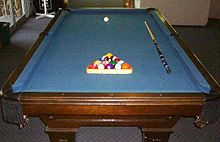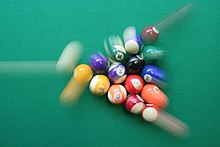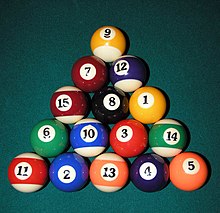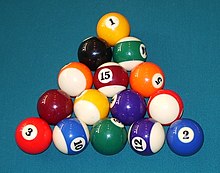Pool

Pool billiards is a variant of billiards in which the aim is to play colored object balls according to certain rules in six pockets with a white game ball ( to pocket them ) . The cue ball is the only ball that is played with the help of the cue . The players take turns each one recording . The recording is over when the player has not been able to properly punch a ball in one shot.
history
In the 1840s the game of billiards was played in so-called (public) "pool parlors" in the USA , as tables were very expensive and often had to be imported from Europe. The word "pool" referred to the game of chance at the time, but was quickly used for the American form of pocket billiards. Nowadays the short version “pool” is used almost exclusively in common parlance.
Up until the middle of the 20th century, pool billiards was not particularly popular; until then , four-ball carom was largely played. Pool evolved from English Billiards , the forerunner of snooker . When a ball and bags were removed at English Billiards , the number of balls at the pool was increased and the bags were retained. In order to simplify the tables for inexperienced players, the pocket inlets were changed from the classic round version of English billiards to the straight, funnel-shaped version that is still common today.
The first pool championship was won in 1878 by the Canadian Cyrill Dion (he and his brother Joseph invented the " American Series "). The game was called "61-Pool" because the sum of the numbers (1–15) shown on the balls is 120, so 61 points are required to win. This meant that ideally you only had to sink 5 balls (11, 12, 13, 14 and 15), i.e. only a third of the balls available. It seemed more equitable that you had to pocket eight balls to win, the most famous version of the pool to this day . This version called " 8-Ball " was developed around 1900. In 1920, " 9-Ball " was created for the first time . In recent times, however, this game has largely been replaced by the further developed " 10-Ball " in order to increase the level of difficulty.
material
table
The international standard for pool tables is the nine foot pool table. It has a standardized playing area of 2.54 × 1.27 m.It is kicked from the head field, the first quarter of the area on which the head point is located, which is in the middle of the head line. Then comes the center line with the center point. The foot point and foot line are in the lower quarter of the table. The diamonds, so called because of their original shape, which divide each gang into equal sections, are aids for gang play.
Bullets
Today's balls are made of phenolic resin and have a diameter of 57.2 mm and a weight of 170 g.
Color classification:
- Match ball: white or white with red dots 1
- 1/9 = yellow
- 2/10 = blue
- 3/11 = red
- 4/12 = purple or pink 1
- 5/13 = orange
- 6/14 = green
- 7/15 = dark red or brown 1
- 8 = black
1 There are differences between normal ball sets and the TV set, in which the colors are slightly different from the original colors due to better visibility on TV. Match balls with red dots convey the spin used better to the audience .
In order for a pool billiard machine - with a coin slot for a game in which the colored balls are gradually "sunk" and retained - to keep returning the white game ball to the end, it must be distinguishable. Mostly the whiteness measures 3 mm more in diameter, i.e. 60.2 mm, on the other hand smaller ones - with 50.8 to 54 mm - are offered, more expensive is an identical diameter of 57.2 mm with ferromagnetic core. Smaller and larger ones fall down when rolling over a gradually widening slot between two rolled edges at different points. Magnetic force pulls a ball with an iron core on a switch to one side.
Billiard cue and chalk
The cue is the stick with which the ball is kicked in billiards. From the middle of the 18th century, cues became popular instead of the curved rackets that had been common up until then. At pool they usually consist of two parts, the upper and the lower part.
The majority of club players use a so-called kick-off or English in addition to the game queue. Break queue, which is often in three parts. The lower part of the three-part break / jump cue is divided again so that it can be shortened to approx. 1 m by unscrewing the thick lower part to make jumps over obstacle balls easier.
The billiard chalk is applied to the bitter orange at the tip of the cue. It ensures better adhesion between bitter orange and cue ball, especially when playing with spin.
Terms
The Positioning describes the selective deposition of the game ball (and to a lesser extent the object balls) on the table. In the ideal case, after the object ball has been punched, the cue ball runs onto the place provided by the player. This is important in order to be able to continue playing effectively afterwards. This requires a lot of practice and skill. The game of spin is an important means of steering the cue ball.
Rack or board is the name given to the original structure of the balls (mostly in a triangle; in some disciplines, however, also in other geometric shapes) at the start of the game.
The opening kick is also called break or break-in in pool billiards .
Certain disciplines allow the playing of a so-called security (Engl. Safety ). This must be announced before a burst. If this happens, the player must and may not continue to play even after the object ball has been sunk. This is mostly used when the player already suspects that after sinking it will no longer be possible to continue playing or that the opponent will be in a difficult initial situation.
If an object ball is hidden in such a way that it cannot be played directly, it is said that the ball is dark, dead or safe.
A recording is the period of time in which a player stands at the table continuously.
An ace or a committee (or internationally from the English: table-run ) describes the game win from the break in a shot, i.e. without the opponent being able to execute a push.
"Ball in hand" refers to the free improvement of the position of the ball on the entire table, which is given as a punishment for a foul by the opponent.
A jump or jumpshot is a push that lets the cue ball take off in order to jump over one or more object balls. The cue is raised in such a way that the cue ball is "pushed into" the table so that it bounces back from the table. A prerequisite for a regular jump shot is that you hit the ball above its equator. Jumps that are achieved by playing the game ball below their equator are not compliant with the rules. There are special jump queues for taking jumpshots.
A stop ball is a kick in which the cue ball is played in such a way that it immediately remains still after contact with an object ball. In a stun shot , the cue ball does not hit the exact center of the object ball and then moves parallel to the tangent that runs through the contact point of cue ball and object ball (stop ball or kiss-shot tangent) . In the case of an exactly played stop ball / stun shot , the cue ball may no longer rotate at the moment of impact. The player achieves this by hitting the cue ball below its center so that at the moment of impact the sliding friction cancels the rotation of the cue ball.
The stop ball becomes a return if the cue ball is still rotating backwards at the moment of contact with the object ball. The ball breaks out of the natural angle in the direction of the player. If the ball is hit in the middle, this means that the cue ball runs back in the direction of the cue.
In the case of a follower , the cue ball breaks away from the player at its natural angle. The follow-up occurs when the player hits the cue ball at the top (forward effect) to give it additional forward rotation, or when the player hits the cue ball centrally and it then has enough space on the table to take up rotation after an initial phase of sliding.
Grandma or bridge is a loving expression for the auxiliary cue , which is needed if you cannot get to it or only with difficulty due to the position of the game ball. There are different types of auxiliary cues. The most common are low bridge , high bridge, and swan .
For an arc thrust the white ball is cut with as much spin as possible. If the rear of the cue is raised, the effect increases. Side and simultaneous forward or backward action force the cue ball on the grippy cloth onto a hyperbolic path.
Banker (spoken banker) or ribbons denotes the game on the gang.
With combinations you play an object ball on a second to sink it. Depending on the number of contacts, such joints are also referred to as doublets , triplets, etc.
Kiss shot refers to the case that the game ball ricochets off an object ball and then sinks another object ball.
On the other hand, a sawtooth is a push in which the ball pushed by the cue ball made at least two board contacts before falling into a pocket.
A cue extension is an aid that is placed on the back of the handle of the cue in order to be able to play the cue ball even when it is difficult to reach. There are cue extensions for screwing (usually approx. 15 cm) and for attaching (mostly extendable approx. 40 to 97 cm). Cue extensions are rarely used in pool, they are more often needed in snooker , as the snooker table is larger than the pool table.
General pool rules
- What all types of pool have in common is that any ball has to run into a gang or be sunk after the collision.
- As soon as a ball bounces off the table, there is a foul.
- Piercing is not allowed. A puncture occurs when the tip of the cue hits the cue ball a second time or still touches the cue ball when it comes into contact with the object ball. This can happen, for example, when the cue ball is very close to an object ball.
- Pushing or touching the balls is not allowed while the balls are still moving. This also includes rotating around its own axis without the ball changing its position.
- It is still not allowed to hit the balls with anything other than the tip of the cue.
- You always commit a foul when you hit an incorrect stroke. Depending on the discipline, a foul is punished differently.
Disciplines
There are many disciplines in pool billiards. For the players organized in the club, the game rules pool billiards and other regulations apply . In detail, the games differ in the details, tactics and handling of fouls.
The disciplines with the greatest importance (official league disciplines of the German Billiard Union DBU ) are:
- 8 ball
- 9-ball
- 10 ball
- 14.1 endless (short: 14/1 or 14 / 1e ; in English-speaking countries: straight pool )
There are also numerous other disciplines such as 3-Ball , Artistic Pool , Bank Pool , Blackball , Cribbage Pool , High Run , Kelly Pool , One Pocket and Rotation .
8 ball
In the 8-ball game, all fifteen object balls and one cue ball are used. The balls with the numbers one to seven are completely colored and are therefore called the full ones . In contrast, balls nine to fifteen only have one colored stripe and the rest is white, which is why they are also called halves .
Both players must first try to punch holes completely in their color group in order to then be allowed to sink the black eight, which, if done correctly, leads to the game being won. 8-ball is an announcement game, i. H. In case of doubt, you have to say which ball should fall into which pocket. The exception is the break .
8-ball is the most popular pool variant in the amateur sector and is mainly played in restaurants and billiard salons.
9-ball
With 9-ball, the first nine of the numbered object balls and one cue ball are played. Before the break , they are arranged in a diamond shape. For each shot, the ball with the lowest number must be played first. The first player to correctly punch ball number 9 wins. However, it is permissible to punch a ball that is not yet your turn, as long as you first hit the ball with the lowest number (“combination”).
9-ball is not an announcement game, so random hits are allowed. There are no safety announcements in 9-Ball, so the player has to stay at the table even after a chance hit. It is often played in tournaments because it is quite a fast and spectacular game.
14 and 1 endless
With 14 and 1 endless (short: 14/1 or 14 / 1e; in English: Straight Pool) all fifteen object balls and one cue ball are played.
It is a points game where the goal is to achieve a certain number of points. You can pocket any object ball and you always get one point for it, for a foul you get 1 point deducted. For three consecutive fouls there is a deduction of 15 points. Negative points are possible.
The name 14 and 1 endless comes from the fact that you pocket 14 object balls. One remains and the rack is rebuilt (the space on the base remains free) and you can continue playing. This last object ball should be in such a way that you can then sink it and at the same time loosen the rack in order to continue playing. It is thus possible to achieve the output target in a single recording .
14 and 1 is an announcement game in which, unlike 8-ball, there is no exception rule for the break . Therefore, one often sees safety impulses in this discipline.
3 ball
3-Ball is played with three numbered object balls, which are set up in a triangle at the beginning. The aim of the game is to punch all three balls in the correct order in as few shots as possible. Every push, including the push, counts as a point. In contrast to other disciplines, there is no change of shot in 3-ball .
10 ball
In the case of 10-ball, the first ten of the numbered balls and a cue ball are played. Similar to the 9-ball , the balls must be played in ascending order, but in case of doubt it must be announced before each shot which ball will be played in which hole. This reduces the random component present in the 9-ball.
The aim of the game is to pocket the ball with the number 10 after announcing it with a correct stroke.
Artistic pool
The Artistic Pool is a special type of pool where curious and seemingly impossible art shots are shown. The aim of the game is to cope with given bumps from a catalog. As a rule, you have three attempts to execute a shot, but you only get full points if you manage it in the first attempt. For each push there are between six and ten points, depending on the difficulty.
Bench pool
The bank pool is played with either nine or fifteen object balls and one cue ball. Any ball can be played, but unlike all other pool versions, it must be punched over the board, so the object ball must first be played into the board before it ricochets off the board and rolls towards the hole. Bank Pool is an announcement game.
The name of this variety is also derived from this peculiarity, since the English word bank corresponds to the German word bande.
One pocket
The One Pocket is played with fifteen object balls and one cue ball. Similar to the 14/1, each ball counts one point and no distinction is made between the balls. The peculiarity of the One-Pocket is that for the player only balls that fall into his - previously determined - hole count. Which player tries to play his balls in which hole is determined at the beginning of the game.
rotation
The rotation involves playing with all fifteen object balls and one cue ball. Similar to the 9-ball , the ball with the lowest number must always be played; however, it does not have to be announced what is to be punched. For every properly punched ball there are points - according to its number. The first player to reach 61 out of 120 possible points wins.
The balls are set up in a triangle at the beginning, with the 1 in front, the 2 on the left, 3 on the right corner and the 15 in the middle of the triangle. In the opening shot, the player must play the 1 and thus let at least four balls run into a gang or pocket a ball.
House rules
Pool billiards, as a popular game in pubs, has experienced many house rules over the course of time, some of which are also assumed to be official by the players. Usual variants can include various changes to the tournament rules, such as
- Certain assembly rules according to numbers or color symmetries
- Determination of the color allocation even by sunk balls at the kick-off (with the 8-ball)
- Game without notice of bumps
- Various forms of punishment for invalid strikes, e.g. B. an additional penalty for the opponent and / or kick from the head field of the table
- When kicking off from the head field of the table, only own balls that are beyond the center line may be played.
- Permission to move bullets lying on the board a queue width away
- Indirect hits on the opponent's balls, d. H. after the cue ball has touched the boards are often not seen as a foul.
- Compulsory game of the black ball in the opposite pocket of the last sunk normal ball or occasionally in the same pocket (with 8-ball)
- If a player punches the black ball on the break, he wins (with 8-ball)
All these variants do not correspond to the sport of pool and are used in different regions and by different groups in different combinations. For example, the two-shots rule, i. H. the granting of an extra shot to the opponent after a foul, an integral part of UK House Rules.
Game variants for 3 players
Cutthroat
In the cutthroat, the balls are divided into 3 groups: 1 to 5, 6 to 10 and 11 to 15. Before the game, each player chooses one of these three groups as his own balls. The aim of the game is to only sink the opposing balls. If a player pits his own ball or no ball at all, it is the next player's turn. If a player has no more balls of his own at the table, he is eliminated as the loser and the other two players continue to play. The player whose balls are left at the end of the table wins the game.
Trillard
Trillard is a variation of the 8-ball in a threesome. The balls are divided into 3 play groups according to their colors: 1, 9, 5, 13 (yellow and orange) 2, 10, 4, 12 (blue and purple) 3, 11, 7, 15 (red and brown). The first player can either pocket any ball from one of these 3 groups and must then choose this as his own balls. The other two groups can be chosen by the other two players as soon as one of them sinks one of the first balls. It is a player's turn as long as he sinks his own balls. The two green balls (6 and 14) are considered "jokers" and can be pocketed by any player at any time in order to continue playing. The aim of the game is (similar to the 8-ball) first to sink your own 4 balls and then to end the game with the black 8.
Pool in the film
Two of the best-known films about pool are Sharks of the Big City from 1961 and The Color of Money with Tom Cruise from 1986. Paul Newman embodies the pool player "Fast Eddie Felson" in both. The first part in particular is considered to be one of the best gamer films ever. With one exception, all pool shots were executed by the actors Paul Newman and Jackie Gleason themselves; only one particularly complicated thrust comes from Willie Mosconi , fourteen-time world champion from 1941 to 1957. Recent films about pool include the 2002 film "Poolhall Junkies" by Mars Callahan and the German production Alles on sugar! with Henry Hübchen .
See also
- 1. Bundesliga Pool - highest German league in pool
- German pool championship - German individual championship
literature
- Andreas Huber (billiard trainer ) : really billiards. BLV, Munich 2007, ISBN 978-3-8354-0132-7 .
- Ralph Eckert : Modern pool. Techniques and training. 4th edition. Litho, Speyer 2003, ISBN 3-9804706-0-1 .
Web links
- DBU German Billard Union
- Austrian pool billiards association
- Swiss Billiards Association Pool Section
Individual evidence
- ^ History of Pool and Billiards. (URL) (No longer available online.) Archived from the original on January 26, 2014 ; accessed on January 26, 2014 .
- ↑ Official game rules pool of the German umbrella organization DBU (status 07/2016)
- ↑ Official other game regulations pool of the German umbrella organization DBU (as of 07/2016)
- ↑ Michael Denks: Sharks of the Big City. (No longer available online.) In: Zelluloid.de. October 23, 2008, archived from the original on March 22, 2014 ; accessed on September 17, 2018 .












